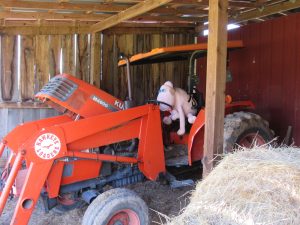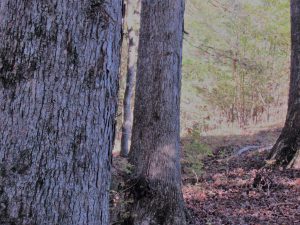No matter what kind of trouble a teenage boy might get into on a Friday night, he will be home in time to raid the fridge for a midnight snack. It is a plain and simple fact of nature. Home is where the stomach gets filled, as the adage goes (or should).

Apparently one of our guests gifted us this “farm helper” last night.
Of all the skills we have learned on the farm (and we have learned plenty in 22 years), among the first and most critical lessons in Husbandry 101 is the importance of hollering for dinner. Teach your livestock to come to feed and your life has been made much easier. Call them even when they’re confined to a barn. Let them associate your bellow with getting fed. They will love you for it.
Yes, stepping out into a field for the first time and hollering for cattle with neighbors in earshot makes you feel like a right idiot. Get over it. I have been with friends who struggled with controlling their livestock. The reason was clear. As the herd ran rampant over distant fields, they would stand in the barn doorway with a bucket and say “Here cattle, come here cattle” and shake the bucket like it was filled with feathers that were about to float away.
You can’t pussyfoot around — you have to call your livestock like you mean it. Start by getting them used to a little feed every day. When we first get a load of weanling pigs, we keep them confined for 24 hours. Each time they get fed, even though they are five feet away, we holler, “Here piggee, piggee, piggeeee!” (The classic “Sooey!” used to call pigs is said to derive from the Latin Suidae, the family that includes domestic hogs.)
Walking out to the barn at sunset and giving a holler, “Here chick, chick, chick!” then watching the chickens, heads down at a fast waddle, stream from all points of the compass. When you’re under the gun and required to treat a lamb for scours right now, shaking a bucket and blasting out a booming “Come on, girls, come on!” then having 50 ewes and lambs stampede toward you from 400 yards away. Those immediate responses to your call are more than just satisfying; they’re critical.
Pigs, though, are somewhat different. They will come running if still confined to their paddock. But if they have escaped, slightly different rules apply. They may, if hungry (and pigs, like boys, are almost always hungry), follow your cries and a bucket of feed back to home and hearth. Or they may ignore you. (In which case they will typically return overnight, homed in on the trough of feed … unless, of course, they don’t. See Big Sandy Callin’.) Regardless, recapture is more easily done when any stock have been handled and when they associate the sound of your distinctive call with safety and feed.
Last night several couples joined us for a St. Paddy’s dinner celebration. Shortly after arriving, one of the couples told us of a flock of sheep out on the road a couple of miles away. Cindy and the couple went to assist. Turns out, the farmer was out of state and unable to help. Twenty-odd lambs had already scattered every which direction, and only a flock of 8-10 greeted the three and one other neighbor. It was apparent those lambs had never been “called to dinner,” or even left their barnyard. How much more smoothly things would have gone if with a simple holler of “Come on, girls” and the rattle of a bucket they had turned toward home. As it were, after 40 minutes of coaxing lambs toward their barn half a mile away and vehicles stacking up on the country road, Cindy and guests turned and headed home for their own dinner, leaving the job in the hands of the newly gathered reinforcements to finish.
Was it a coincidence that we who had stayed at the farm had just stepped out on the porch and yelled, “Come on, Cindy, come on”?
………………………………………………………………………………….
Reading this weekend: Drink time! in the company of Patrick Leigh Fermor (D. Payas). A short memoir of time spent with PLF by his Spanish translator.


